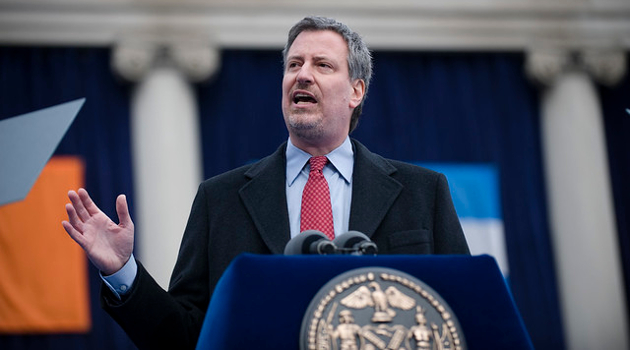New York is in trouble from bad economic policy, especially excessive taxing and spending.
This is one of the reasons why there’s been a steady exodus of taxpayers from the Empire State.
 The problem is especially acute for New York City, which has been suffering from Mayor Bill De Blasio’s hard-left governance.
The problem is especially acute for New York City, which has been suffering from Mayor Bill De Blasio’s hard-left governance.
To be sure, not all of the city’s problems are self-inflicted. The 2017 tax reform removed the IRS loophole for state and local tax payments, which means people living in places such as NYC no longer can artificially lower their tax liabilities. And the coronavirus hasn’t helped, either, particularly since Governor Cuomo bungled the state’s response.
The net result of bad policy and bad luck is that New York City has serious economic problems. And this leads, as one might expect, to serious fiscal problems.
What’s surprising, however, is that the normally left-leaning New York Times actually wrote an editorial pointing out that fiscal restraint is the only rational response.
New York is facing…a budget hole of more than $5 billion… Mayor Bill de Blasio has asked the State Legislature to give him the authority to borrow… But borrowing to meet operating expenses is especially hazardous. Cities that do so over and over again are at greater risk of the kind of bankruptcy faced by New York in the late 1970s and Detroit in 2013.
…Before Mr. de Blasio adds billions to the city’s debt sheet…he needs to find savings. …The city’s budget grew under Mr. de Blasio, to $92 billion last year from about $73 billion in 2014, his first year in office. Complicating matters, the mayor has hired tens of thousands of employees over his tenure, adding significantly to the city’s pension and retirement obligations. …the mayor will have to be creative, make unpopular decisions and demand serious cost-saving measures… One way to begin is with a far stricter hiring freeze. …The mayor will need to do something he has rarely been able to: ask the labor unions to share in the sacrifice. …There are other cuts to be made.
Wow, this may be the first sensible editorial from the New York Times since it called for abolishing the minimum wage in 1987.*
Mayor De Blasio, needless to say, doesn’t want any form of spending restraint. Depending on the day, he either wants to tax-and-spend or borrow-and-spend.
Both of those approaches are misguided.
Kristin Tate explained in a column for the Hill that the middle class suffers most when class-warfare politicians such as De Blasio impose policies that penalize the private sector.
Finance giant JPMorgan is…slowly relocating many of its operations and jobs to lower tax locations in Ohio, Texas, and Delaware. The Lone Star State currently hosts 25,000 of its employees, and Texas will likely surpass the New York portion in coming years. The resulting move will harm the middle earners of New York far more than that of the wealthy… The exodus is part of a trend sweeping traditionally Democratic states over the last several years.
…A whopping 1,800 businesses left California in 2016 alone, while manufacturing firm Honeywell moved its headquarters from New Jersey to greener pastures in North Carolina. …the primary losers in this formula are middle class workers. Between the loss of jobs and revenue, these states and cities press even harder on millions of middle income taxpayers to make up the difference. …Many of the Democrats…who are in charge of the blue state economic models…love to preach that their proposals will make the economy fairer by targeting the most productive members of their states and cities. However, the encompassing butterfly effect spells bad news for people like you and me. Every time you vote for a proposition or a candidate promising a repeat of bad policy, just remember that it will ultimately be the middle class that will pay the largest share.
My contribution to this discussion is to point out that New York City’s fiscal problems are the entirely predictable result of politicians spending too much money over an extended period of time.
In other words, they violated my Golden Rule.
Indeed, the burden of government spending has climbed more than three times faster than inflation during De Blasio’s time in office.
If this story sounds familiar, that’s because excessive spending is the cause of every fiscal crisis (as I’ve noted when writing about Cyprus, Alaska, Ireland, Alberta, Greece, Puerto Rico, California, etc).
My final observation is that New York City’s current $5 billion budget shortfall would be a budget surplus of more than $6 billion if De Blasio and the other politicians had adopted a spending cap back in 2015 and limited budget increases to 2 percent annually.
*The New York Times also endorsed the flat tax in 1982, so there have been rare outbursts of common sense.
———
Image credit: Bill de Blasio | CC BY-SA 2.0.


